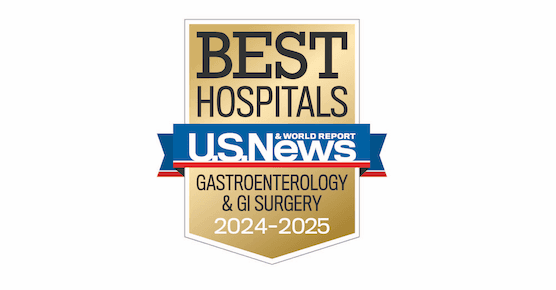Cirrhosis
For patients suffering from cirrhosis, slowing down the progression of this serious illness may help preserve your remaining liver function. That’s why it’s important to diagnose what’s causing your cirrhosis as quickly as possible. At the Center for Liver Diseases at the University of Chicago Medicine, our liver specialists offer expert diagnosis and treatments with the goals of helping you cope long term and reducing your likelihood of needing a liver transplant.
What is Cirrhosis?
Cirrhosis is the term given to a severely scarred liver that risks losing its ability to function normally. Cirrhosis is a chronic complication brought on by many causes; when no treatable cause is found, the scarring continues to build up over time. Although there is no cure for cirrhosis, treatment plans can control or slow its progression.
Frequently Asked Questions About Cirrhosis
Typical signs, symptoms and complications of cirrhosis include:
- Fatigue; generalized weakness
- Malnutrition or weight loss due to poor appetite or recurrent vomiting
- Yellowish skin and eyes (jaundice), which may be accompanied by itching
- Swollen belly and/or legs
- Poor mental function, such as confusion or mood changes (hepatic encephalopathy)
- Easy bruising of the skin
- Dilated veins in the esophagus and stomach
- Intestinal bleeding
Cirrhosis can be caused by several factors. The most common causes are:
- Long-term alcohol abuse
- Hepatitis (viral and autoimmune hepatitis)
- Fatty liver disease
- Diseases of the bile ducts, which slow or prevent bile flow from the liver to the intestine
- Inherited diseases, including alpha1-antitrypsin deficiency, cystic fibrosis and accumulations of copper (Wilson disease) or iron (hemochromatosis)
Your doctor will do a complete health history and physical exam. In order to accurately diagnose cirrhosis, as well as what’s causing it, it will be important for your doctor to understand your medical history. Other tests used to diagnose cirrhosis include:
- Blood tests, such as liver function tests, to see whether your liver is working the way it should.
- Imaging. Ultrasound uses high frequency sound waves to create a picture of your liver. CT scans use X-rays to produce detailed images, while MRI uses a magnetic field and radio frequency pulses to produce comprehensive pictures of your liver.
- Elastography. Transient Elastography (Fibroscan®) is a special ultrasound that measures the amount of fat in the liver and the stiffness of the liver, which are indirect measures of the amount of scarring present. MR Elastography is a special way of obtaining an MRI that also measures the amount of fat in, and stiffness of, the liver.
- A liver biopsy involves removing small tissue samples from the liver with a needle, then checking these samples under a microscope to diagnose the type of disease and determine the severity of damage it’s causing to the liver.
Learn more about diagnostic tests and procedures for liver diseases
Your doctor will discuss with you the best treatment plan. Depending on your diagnosis, it may include one or more of the following steps:
- Stopping all alcohol use. Even a small amount of alcohol can cause problems for patients with known cirrhosis. If you have problems quitting alcohol, ask your health care provider for help finding the support you need to stop drinking.
- Taking medicine. You may need medications to treat the cause of the cirrhosis, like hepatitis B or C, Wilson disease, or if your immune system is attacking your liver. You may also have to stop taking certain medicines that can potentially damage the liver.
- Losing weight. If your cirrhosis is being caused by fatty liver disease, losing weight if you are overweight and controlling diabetes and cholesterol levels can help reduce the amount of fat stored in your liver.
- Removing iron from your blood. If the amount of iron in your liver is higher than normal (hemochromatosis), your doctor may treat it by regularly drawing your blood in a method similar to donating blood.
- Improving bile flow. If there’s a blockage of a bile duct, procedures may be performed to open up the blockage and restore proper bile flow out of the liver.
Cirrhosis itself usually can’t be cured, so treating it involves continuous monitoring and therapy to prevent or address complications from the condition. Your doctor may recommend:
- Eating a healthy diet including adequate amounts of protein to avoid muscle wasting.
- A low-salt diet and taking water pills to help ease swelling in your stomach and legs caused by cirrhosis.
- Taking medication, such as a beta blocker (to prevent bleeding from dilated veins in the esophagus or stomach) or lactulose and/or certain antibiotics (to treat changes in thinking due to high ammonia levels, called hepatic encephalopathy).
- Periodic testing, including liver function tests, to monitor your liver’s capacity to perform its work.
- Periodic imaging of your liver to monitor for signs of cancer.
- Liver transplantation if your liver is no longer functioning well or has a small cancer.

Cirrhosis Q&A with a Liver Disease Expert
Helen S. Te, MD, explains the most common misconceptions about cirrhosis.
Read more about cirrhosis
Nationally Ranked in Gastroenterology and GI Surgery
According to U.S. News & World Report's 2024-25 Rankings.
Learn more about U.S. News Best HospitalsLiver Transplant Evaluation Locations in Chicagoland
Request an Appointment
We are currently experiencing a high volume of inquiries, leading to delayed response times. For faster assistance, please call 1-888-824-0200 to schedule your appointment.
If you have symptoms of an urgent nature, please call your doctor or go to the emergency room immediately.
* Indicates required field
